Resident Evil, known as Biohazard in Japan, is a Japanese horror game series and media franchise created by Capcom. It consists of survival horror, third-person shooter and first-person shooter games, with players typically surviving in environments inhabited by zombies and other mutated creatures. The franchise has expanded into other media, including a live-action film series, animated films, television series, comic books, novels, audiobooks, and merchandise. Resident Evil is the highest-grossing horror franchise.
Survival horror is a subgenre of horror games. Although combat can be part of the gameplay, the player is made to feel less in control than in typical action games through limited ammunition or weapons, health, speed, and vision, or through various obstructions of the player's interaction with the game mechanics. The player is also challenged to find items that unlock the path to new areas and solve puzzles to proceed in the game. Games make use of strong horror themes, such as dark mazelike environments and unexpected attacks from enemies.
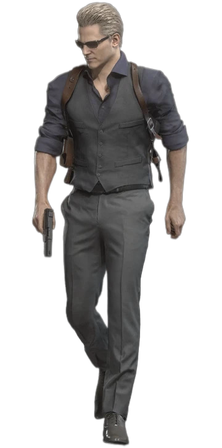
Albert Wesker is a character in the Resident Evil survival horror video game series created by the Japanese company Capcom. He was first introduced in the original Resident Evil (1996) as the captain of the Special Tactics and Rescue Service (S.T.A.R.S.) unit of the Raccoon Police Department. Wesker has been one of the series' main antagonists as a member of the pharmaceutical conglomerate Umbrella Corporation, the primary antagonistic faction, manipulating story events behind the scenes. To further his own plans, Wesker betrays his allies, fakes his death, gains superhuman abilities, and works with both Umbrella's mysterious rival company and their successors in the field of biological weapons development until his ultimate defeat by Chris Redfield and Sheva Alomar in Resident Evil 5 (2009).

Resident Evil Zero is a survival horror video game developed and published by Capcom for the GameCube in 2002. It is a prequel to Resident Evil (1996), covering the ordeals experienced in the Arklay Mountains by special police force unit, the S.T.A.R.S. Bravo Team. The story takes place in July 1998 and follows officer Rebecca Chambers as well as convict Billy Coen as they explore an abandoned training facility for employees of the pharmaceutical company Umbrella. The gameplay is similar to other Resident Evil games, but adds the ability to switch between characters to solve puzzles and use unique abilities.

Resident Evil is a 1996 survival horror game developed and published by Capcom for the PlayStation. It is the first game in Capcom's Resident Evil franchise. Set in the fictional Arklay mountain region in the Midwest, players control Chris Redfield and Jill Valentine, members of the elite task force S.T.A.R.S., who must escape a mansion infested with zombies and other monsters.
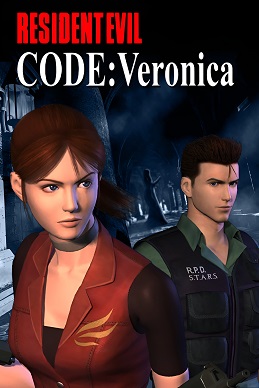
Resident Evil – Code: Veronica is a survival horror video game developed and published by Capcom and originally released for the Dreamcast in 2000. It is the fourth main installment in the Resident Evil series and the first to debut on a separate platform from the PlayStation. The story takes place three months after the events of Resident Evil 2 (1998) and the concurrent destruction of Raccoon City as seen in Resident Evil 3: Nemesis (1999). It follows Claire Redfield and her brother Chris Redfield in their efforts to survive a viral outbreak at a remote prison island in the Southern Ocean and a research facility in Antarctica. The game retains the traditional survival horror controls and gameplay of previous installments; however, unlike the pre-rendered backgrounds of previous games, Code: Veronica uses real-time 3D environments and dynamic camera movement.

Resident Evil 5 is a 2009 third-person shooter video game developed and published by Capcom. It is a major installment in the Resident Evil series, and was released for the PlayStation 3 and Xbox 360 consoles in March 2009 and for Windows in September 2009. It was re-released for PlayStation 4 and Xbox One in June 2016. The plot involves an investigation of a terrorist threat by Bioterrorism Security Assessment Alliance agents Chris Redfield and Sheva Alomar in Kijuju, a fictional region of West Africa. Chris learns that he must confront his past in the form of an old enemy, Albert Wesker, and his former partner, Jill Valentine.

Shinji Mikami is a Japanese video game designer, director, and producer. Starting his career at Capcom in 1990, he has worked on many of the company's most successful games. He directed the first installment of the Resident Evil series in 1996 and the first installment of the Dino Crisis series in 1999, both survival horror games. He returned to Resident Evil to direct the remake of the first game in 2002 and the survival horror third-person shooter Resident Evil 4 in 2005. In 2006, he directed his final Capcom game God Hand, a beat 'em up action game. Mikami founded PlatinumGames in 2006 and directed the third-person shooter Vanquish in 2010. That same year he left the studio and founded a new studio Tango Gameworks and directed the survival horror game The Evil Within in 2014. He has also served the roles of producer and executive producer for many games. In 2023, he left the studio and founded a new studio KAMUY in 2024.

Sweet Home is a role-playing video game developed and published by Capcom for the Family Computer in 1989. It was developed alongside the horror film of the same name and tells the story of a team of five filmmakers exploring an old mansion in search of precious frescos hidden there. As they explore the mysterious mansion, they encounter hostile ghosts and other supernatural enemies. The player must navigate the intricately laid out mansion, battling with the enemies, and the five main characters with the limited weapons and health restorative items available. The narrative moves forward regardless of whether the characters stay alive, and leads to its five different endings.

Haunted House is a 1982 adventure video game programmed by James Andreasen for the Atari Video Computer System and published by Atari. The player controls an avatar shaped like a pair of eyes who explores a mansion seeking out parts of an urn to return to the entrance. The game world is populated by roaming enemies including vampire bats, tarantulas, and a ghost. Haunted House was among the first games to use player-controlled scrolling between large portions of the visual space.
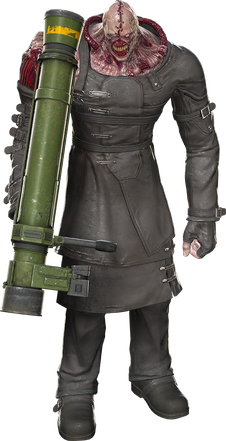
The Nemesis, also called the Nemesis-T Type, or the Pursuer in Japan, is a character in the Resident Evil survival horror video game series created by Capcom. Although smaller than other Tyrant models, the creature dwarfs a typical human, and possesses vastly superior intelligence and physical dexterity to its undead peers. It is featured in Resident Evil 3: Nemesis (1999) as a titular main villain before later emerging in other titles and cameo roles. It is also featured on various merchandise and was portrayed by Matthew G. Taylor in the 2004 film Resident Evil: Apocalypse. The character is voiced by Tony Rosato in the original game and Gregg Berger in Operation Raccoon City (2012). In the 2020 remake of Resident Evil 3, the character is voiced by David Cockman, with Neil Newbon providing the motion capture performance. Nemesis has also been featured in several other game franchises, including as a playable character in Marvel vs. Capcom and Dead by Daylight.

Alone in the Dark is a 1992 survival horror video game designed by Frédérick Raynal. Developed and published by Infogrames in 1992 for MS-DOS, the game was eventually ported to Mac OS, the PC-98, the FM Towns, the 3DO, the Acorn Archimedes, and iOS. Alone in the Dark is set in 1920s Louisiana and challenges the player to escape a haunted mansion. To advance, the player must solve puzzles while banishing, slaying, or eluding various ghosts and monsters. The player can collect and use weapons, manage a weight-based inventory system, and explore a partially nonlinear map.
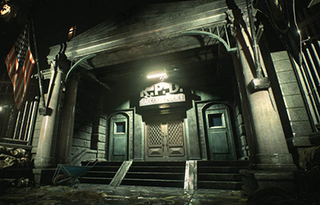
The Raccoon Police Station is a fictional police station that appears in Capcom's Resident Evil survival horror franchise. The headquarters of the Raccoon Police Department (RPD), it is situated in the heart of Raccoon City. It serves as one of the primary settings for Resident Evil 2 and its remake, where it becomes overrun by deadly zombies and the living bioweapon Mr. X. It hides an entrance to the secret research facility of the evil Umbrella Corporation pharmaceutical company. It also appears in numerous subsequent games, including Resident Evil 3: Nemesis and its remake, Resident Evil: The Umbrella Chronicles, and Resident Evil: The Darkside Chronicles.

Rebecca Chambers is a character in the Resident Evil survival horror video game series created by the Japanese company Capcom. She was first introduced as a supporting character in the original Resident Evil (1996) and became a player character of the prequel game Resident Evil Zero (2002). In the first Resident Evil, Rebecca is a young officer with the Raccoon Police Department's Special Tactics And Rescue Service (S.T.A.R.S.) unit and is trapped in a zombie-infested mansion.
Starting with Biohazard i Survivor in 2001, several mobile games based on the Resident Evil survival horror franchise have been released. The games feature different genres and settings, and were developed by the Japanese and Canadian branches of Capcom.
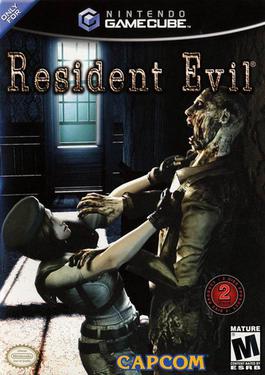
Resident Evil is a 2002 survival horror game developed and published by Capcom for the GameCube. It is a remake of the 1996 PlayStation game Resident Evil, the first installment in the Resident Evil video game series. The story takes place in 1998 near the fictional Midwestern town of Raccoon City where a series of bizarre murders have taken place. The player takes on the role of either Chris Redfield or Jill Valentine, S.T.A.R.S. officers sent in by the city and the R.P.D. to investigate the murders.

Resident Evil: Resistance is a 2020 survival horror game developed by NeoBards Entertainment and published by Capcom as the online component for Resident Evil 3. Released for PlayStation 4, Windows, and Xbox One, it involves four survivor players competing against a mastermind player who can create traps, enemies and other hazards. Resistance is set during the Raccoon City outbreak, featuring some of the characters from Resident Evil 2 and 3. Resident Evil 3 producer Peter Fabiano confirmed that Resistance is non-canon as it is "impossible to fit in the actual timeline". The game received mixed reviews from critics, who criticized the game for being unbalanced, having technical issues and for lacking dedicated servers.
A horror game is a video game genre centered on horror fiction and typically designed to scare the player. The term may also be used to describe tabletop games with horror fiction elements.

Resident Evil 4 is a 2023 survival horror game developed and published by Capcom. A remake of the 2005 game Resident Evil 4, it was released for PlayStation 4, PlayStation 5, Windows, and Xbox Series X/S on March 24, 2023. Versions for iOS, and macOS were released on December 20, 2023.















